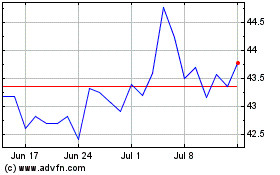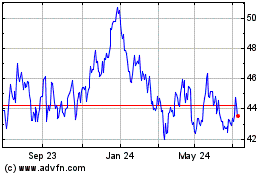By Laurie Burkitt
BEIJING--The China economic slowdown that has rattled global
markets is also shaking the fortunes of multinationals that do
business here.
Those that fed China's traditional boom industries of
infrastructure, energy and steel--like Anglo-Australian miner BHP
Billiton Ltd. and French energy-equipment maker Schneider Electric
SE--are suffering precipitous falls in revenue there after years
when their profits were boosted by the country's 10%-plus economic
growth. Many also face heavy write-downs as investment plans
predicated on surging China demand look increasingly unrealistic as
the country's growth slows.
In contrast, companies like iPhone maker Apple Inc. and luggage
maker Samsonite International SA that cater to China's consumers
are faring much better as retail demand overall remains strong.
"We're spending as much as we always do," said Zhen Lin, a
27-year-old magazine editor on maternity leave, emerging from a
Beijing supermarket with a cart half full of groceries. Ms. Lin
said she eats out several times a week and isn't holding back on
her spending. Among the purchases she is planning: a new computer
this year and a new car some time in the next two.
The shifting fortunes of international companies in the world's
second-largest economy come after two decades when China has not
only been the world's factory floor, but an El Dorado for foreign
companies of all stripes.
Major luxury and retail brands as well as car makers piled in,
becoming as prevalent on the streets of Shanghai as they are in New
York or London. China became the world's largest car market--a
critical venue for companies like General Motors Co. and Volkswagen
AG. Sales of luxury goods in China jumped 30% to 266 billion yuan
($41.4 billion) in 2011, and by 2012, Chinese shoppers made a
quarter of all global luxury purchases. Giorgio Armani SpA had
around 300 stores in China then, just shy of Wal-Mart Stores Inc.'s
380.
Major oil companies like BP PLC and Royal Dutch Shell PLC
invested in projects in China, and hundreds of other industrial
companies boosted output around the world to meet China's demand.
China still consumes nearly half the world's copper and has become
the world's second-largest oil importer. It also consumes 45% of
global steel, but some analysts reckon its demand may have already
peaked.
The slowdown in China's rate of growth that began in 2011 is
changing the equation. Industrial production in July grew 6% over
the year-earlier period, less than half its year-over-year growth
rate of 14% in July 2011. Property development has ground to a halt
as empty malls and apartment buildings dot many of the country's
smaller cities. Office-building construction starts fell nearly 15%
in the first seven months of this year versus a year earlier; in
2014, they'd grown 6.7%.
But retail sales have held up relatively well during the past
few years, with growth slowing to 10.5% in July from 12.2% the same
month last year and 17.2% in 2011.
The contrasting fortunes in the corporate world are stark.
BHP Billiton, the world's biggest miner, which had racked up
$23.6 billion in profit four years ago, last year made only $1.9
billion. On Tuesday it scrapped its long-held belief that China
will produce more than one billion tons of steel a year by the
mid-2020s and now sees output peaking as low as 935 million tons.
U.S. oil giant Chevron Corp. took a $2 billion impairment charge in
the second quarter after a lower crude-price outlook led it to
suspend projects; the company said slower Chinese growth was partly
to blame.
Schneider Electric, one of the world's leading suppliers of
switches, circuit breakers and other electrical gear used in
buildings and power grids, cut its profitability target for the
year, blaming in large part China's slowing growth. The country's
ebbing demand for elevators and escalators as its building boom
cooled hit the Otis elevator unit of United Technologies Corp.,
which in July reported a 5% decline in second-quarter sales.
Caterpillar Inc. said in July that Asia-Pacific sales of its
construction equipment were down 30% in the second quarter, with
much of that decline in China.
Meanwhile, luggage maker Samsonite Wednesday said sales in China
during the first half of the year rose 30% excluding currency
effects, helping push overall revenue to a record $1.2 billion.
Apple said its business in China more than doubled to $13.23
billion in the latest quarter, and Chief Executive Tim Cook assured
spooked investors earlier in the week that its business was still
strong there in July and August. German sportswear brand Adidas
AG's China sales in the first half of the year in China increased
EUR1.16 billion ($1.34 billion), up 20% from a year earlier
excluding currency effects. Much of the growth came from aggressive
expansion across China, where Adidas has more than 8,400
stores.
It is a tale of two economies, said Andrew Polk, economist at
research group Conference Board. "The old growth drivers are
clearly in the tank. The new growth drivers--consumption and
service--are holding up for now, but the jury is still out," Mr.
Polk said.
Some of the strongest corporate performers are targeting a newly
affluent population that looks increasingly like the American
middle class. They are spending for the first time on goodies like
overseas travel, imported food and concert tickets. Demand for
prime splurging products like Japanese diapers, Mexican avocados
and Chilean salmon is surging, and it hasn't been overturned by the
crash in stocks--where average Chinese still have little
invested.
Income is climbing for large segments of the population. Between
2005 and 2012, roughly 50 million urban households graduated into
the middle class, which now numbers around 147 million households,
roughly 49% of China's urban population, according to the Boston
Consulting Group. Those consumers started buying products like Dove
shampoo from Unilever PLC and Crest toothpaste from Procter &
Gamble Co. rather than local goods.
Now, the fastest shift is in households moving to the equivalent
of upper-middle class, with monthly incomes between 12,000 yuan and
20,000 yuan ($1,868 to $3,114) and a taste for spas, organic food
and vacations in Tokyo and Bangkok. BCG estimates there are more
than 25 million of such households now, and the number will more
than triple by 2020.
"We are on the spend side of the economy," said Samsonite Chief
Executive Ramesh Tainwala, adding that many of the company's
customers are first-time overseas travelers. "Despite the 'New
Normal,' the urge to travel has not changed."
Mr. Tainwala said that the price of Samsonite's best-selling
luggage in China has dropped to around $250 from $400 a few years
ago as some of the more reckless spenders of the boom times are
replaced by buyers looking for good value for their money. The
company has reached out to consumers in smaller Chinese cities and
tackled local rivals by stressing its global warranty and
internationally known brand.
To be sure, plenty of consumer-facing firms are also struggling.
Purveyors of luxury goods like Prada SpA have seen sales in China
pummeled by a government crackdown on corruption and extravagance.
Companies like Unilever and P&G that peddle basic consumer
goods have seen sales eroded by a host of savvy local rivals with
soap and shampoo brands that now rival theirs in popularity. Global
car makers have cut back production as sales fall, amid Chinese
government complaints that the companies were overcharging
consumers.
Consumer spending isn't enough to replace the industrial
investment that powered China's economic boom, and if economic
fallout continues, many consumers may lose the jobs that are
fueling their spending. Already Chinese wage growth has slowed in
the past year. Smaller cities, which have been targets for
corporate expansion, may no longer be bright spots for growth,
Conference Board's Mr. Polk said.
Adidas China head Colin Currie said executives plan to keep a
close eye on business, tracking real-time sales data to see if
there is any fallout in China's smallest cities, where the brand
has rapidly expanded in the past five years. The company clusters
its store data by regions and store formats, enabling executives to
compare what strategies are working and to switch everything from
design to distribution for those that aren't.
"We know that the Chinese consumer changes very quickly," said
Mr. Currie. "As a brand and a business, we have to watch these
changes. It's one of our strengths."
Multinationals have seen promise--and sometimes
disappointment--in China's vast consumer market for more than a
century, embodied by an oft-repeated 19th-century saying that if
every man in China added an inch to his shirttail, then the mills
of Lancashire, England, would run for a generation.
Consumer companies were among the first to invest when China
began opening its economy to outsiders in the late 1970s. Coca-Cola
Co., which entered the market in 1978, said in 1980 it would build
its first bottling plant in Beijing. Kentucky Fried Chicken--now
KFC--opened its first outlet in the 1980s and quickly became the
most popular foreign food chain in China.
Heavy industry investment jumped after China joined the World
Trade Organization in 2001. By 2002, foreign direct investment had
jumped to $52.74 billion from $40.4 billion in 1999. By 2011 it had
more than doubled to $124 billion before easing, and last year
totaled $119.57 billion.
Brian Spegele and Phred Dvorak contributed to this article.
Write to Laurie Burkitt at laurie.burkitt@wsj.com
Subscribe to WSJ: http://online.wsj.com?mod=djnwires
(END) Dow Jones Newswires
August 26, 2015 19:28 ET (23:28 GMT)
Copyright (c) 2015 Dow Jones & Company, Inc.
BHP (ASX:BHP)
Historical Stock Chart
From Mar 2024 to Apr 2024

BHP (ASX:BHP)
Historical Stock Chart
From Apr 2023 to Apr 2024
